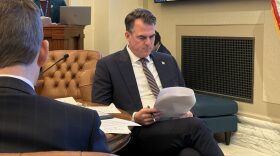Nineteen years after the Oklahoma City bombing, unanswered questions resurfaced last week. A four-day trial in Utah sought to determine if the FBI has done an adequate search for additional videos of the 1995 bombing of the Alfred P. Murrah Federal Building.
Salt Lake City Attorney Jesse Trentadue says he still believes there’s a video showing McVeigh was not alone in detonating the bomb. He’s convinced there’s unseen footage of the Oklahoma City bombing showing two men exiting the yellow Ryder truck parked along Northwest 5th Street between Robinson and Harvey Avenues shortly before 9 a.m. April 19, 1995.
Trentadue says he believes the presence of a second suspect explains why his brother, who resembled a police sketch of a suspect, was flown to Oklahoma months after the bombing. His brother died in a federal holding cell.
U.S. District Judge Clark Waddoups didn't issue a ruling Thursday. Instead, he requested final court briefs summarizing arguments from both sides, and a final decision could be months away.
If you ask most Oklahomans, the 1995 bombing of the Alfred P. Murrah Federal Building is pretty much an open-and-shut case. Timothy McVeigh was executed in 2001, and bombing co-conspirator Terry Nichols is serving a life sentence in Colorado. But an attorney from Salt Lake City who's investigating the death of his brother has uncovered information he feels raises new questions about what the FBI knew and when it knew it.

Kenneth Trentadue’s mutilated body was found dead in an Oklahoma City prison cell in August of 1995. Prison officials say he committed suicide, but Trentadue’s brother Jesse believes Kenney was beaten to death during a botched interrogation after the FBI mistook him for "John Doe #2," a suspect in the Oklahoma City bombing. Documents he’s uncovered also indicate that the bombing may not simply have been the work of a couple of lone individuals, but rather a network of people affiliated with the far right militia movement.
“In trying to find out what happened to my brother, all the trails, all the leads kept taking me back to Oklahoma City and the bombing,” Trentadue tells KGOU. “I doubt my family will ever see justice for my brother’s murder, but in the end, we may get justice for a lot more folks, and maybe that was what it was all meant to be.”
We listen back to an extended version of a 2005 report KGOU aired on the Trentadue case, and we speak to journalist James Ridgeway, whose article "In Search of John Doe No. 2: The Story the Feds Never Told About the Oklahoma City Bombing" appears in the July-August issue of Mother Jones magazine.
Then, for a dose of skepticism, Dr. Lane Crothers joins us in the second half of our program to explain why he thinks it’s entirely possible that two men -- Timothy McVeigh and Terry Nichols -- could have pulled off the entire bombing plot from start to finish without the knowledge or logistical support of a wider circle of people. Crothers is Professor of Politics and Government at Illinois State University and author of the book Rage on the Right: The American Militia Movement from Ruby Ridge to Homeland Security.
WEB EXTRAS:
View the BBC’s timeline of key events before and after the OKC bombing
See photos of Kenneth Trentadue’s body after his death (WARNING: Graphic Content)
------------------------------------------------
KGOU is a community-supported news organization and relies on contributions from readers and listeners to fulfill its mission of public service to Oklahoma and beyond. Donate online, or by contacting our Membership department.









